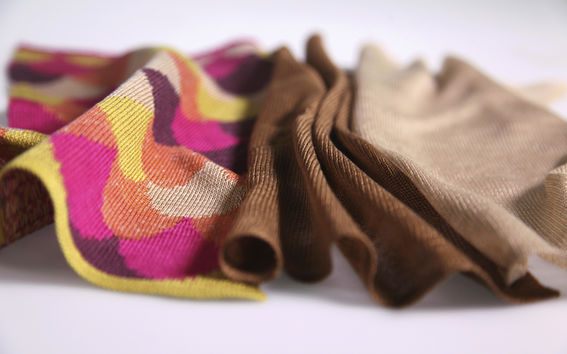Luxury fibre from recycled cardboard

Marjaana Tanttu wanted to emphasise the advantages of recycled fibre. Photo: Eeva Suorlahti
The colourful knitted fabric has a lustrous, silky surface. It's hard to believe that the raw material could have come from the recycling bin in the backyard.
'Based on the feel and smell, no-one would ever guess that these textiles are made from cardboard," confirms Marjaana Tanttu, a doctoral student in textile art and design at Aalto University. She was part of a cooperation project funded by Tekes in which the Ioncell-F spinning method developed by Aalto University Professor Herbert Sixta's research group was used to produce textile fibre from recycled paper and cardboard. The project was carried out in collaboration with VTT.
Unlike viscose manufacturing, which is hard on the environment, the cellulose in Ioncell-F is dissolved using non-toxic ionic liquids developed by University of Helsinki Professor Ilkka Kilpeläinen. The same method was employed as part of the FIBIC research programme to produce birch cellulose fibres, which were subsequently used to manufacture a prototype product together with Marimekko.
'As a designer, I was excited about recycled fibre and I wanted to emphasise the advantages of them. Solid-coloured knits bring out the beautiful shades of the material itself, while the sample woven from dyed thread shows that the material can also be treated with the reactive dyes commonly used in the industry. I also did some experiments to test how the colour of the material itself affects the dyeing result. For example, it takes considerably less dye to obtain a brick-red colour on a brown base than on a white base. It would be wonderful if recycled fibre could also reduce the environmental burden in later stages of textile production,' says Marjaana Tanttu.
Less energy and chemicals
The results of the cooperation project are so promising that The European Paper Recycling Council presented the project partners with The European Paper Recycling Award in October. Environmentally speaking, recycled paper and cardboard are good raw materials for textiles because of the re-use of material and the low level for processing.
'It takes more chemicals and energy to produce pure birch cellulose than paper and cardboard,' explains Postdoctoral Researcher Michael Hummel, who works in Professor Sixta's research group.
'On the other hand, it's much simpler to spin birch cellulose.' This is why VTT, under the leadership of Ali Harlin, had to develop pre-processing methods that rendered the properties of paper and cardboard suitable for spinning very thin fibre.'
Doctoral Candidate Yibo Ma, who was responsible for the fibre spinning, screened several different raw materials. Marjaana Tanttu eventually selected fibres spun from recycled cardboard that contained 15% lignin because of the beautifully matched shades in them.
'It was rewarding to see how cooperation allowed us to obtain such a luxurious material from cardboard. We had to abandon more ambitious experiments because the amounts of material were so small. I had certainly never dyed thread in two-gram batches before this,' she says with a smile.
It will, however, be years before recycled fibre makes its way from the laboratory to the shop. In terms of strength, the fibre is already better than many cellulose-based fibres currently on the market.The next challenge will be up-scaling of production.
'Our consortium has to work now together to test different aspects, such as how to remove ink from the recycled mass,' says Michael Hummel.
Further information:
Article Upcycling of waste paper and cardboard to textiles in Green Chemistry
Herbert Sixta
herbert.sixta@aalto.fi
Michael Hummel
michael.hummel@aalto.fi
Marjaana Tanttu
marjaana.tanttu@aalto.fi
Ali Harlin
ali.harlin@vtt.fi
The Tekes-funded Design Driven World of Cellulose project
Read more news

Aalto Inventors innovation training coming for hydrogen, quantum and microelectronics researchers this spring
Connect with industry and academic thought-leaders and gain widely applicable skills in communication, intellectual property, and business.
Start the year with new insights – apply for FITech's spring courses!
Deepen your knowledge with courses from Finnish universities of technology, designed to meet the demands of the working life and help deepen your expertise for free.






